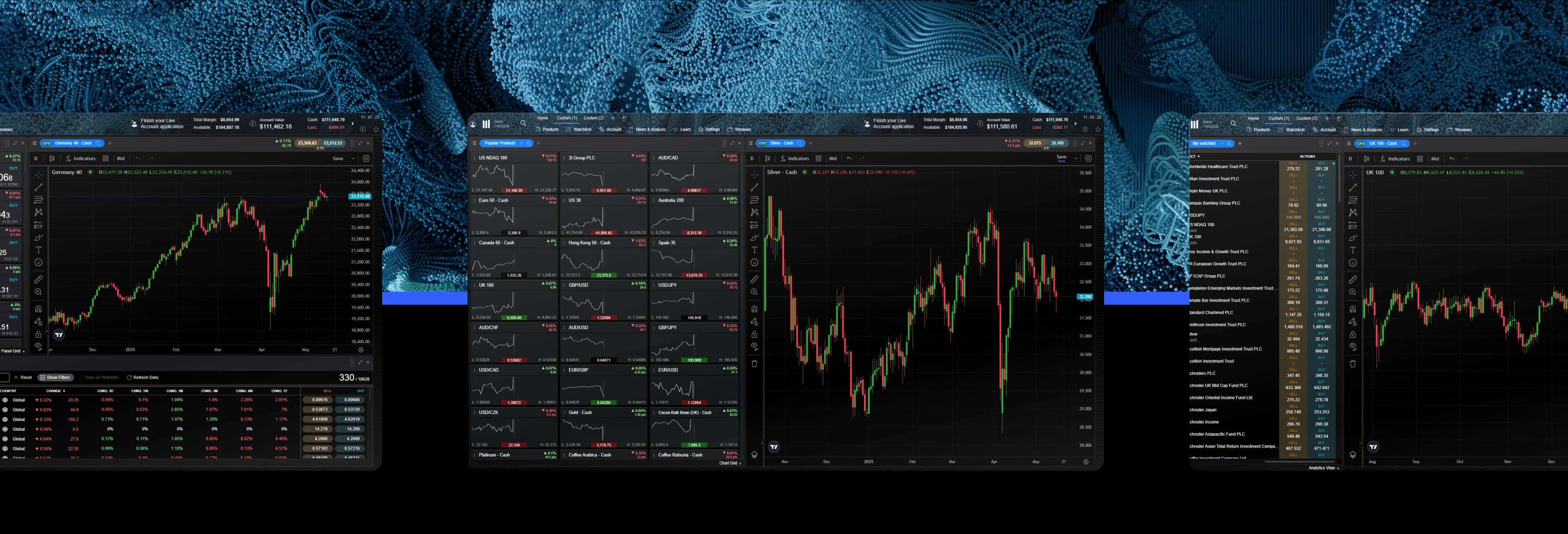
Share trading: buying & selling shares
Share trading is the buying and selling of company stock with the aim of making a profit. Shares represent a portion of ownership of a public company. They make up its market capitalization, or in other words, its value.
For a trader, share (or stock) trading is one of the most popular ways to invest, but there are different ways you can approach share trading. You can make money trading stocks from home and on-the-go with our flexible and easy to use online trading platform.
What is share trading?
When share trading, you buy and take ownership of company stock and sell the stock for a higher price with the aim of making a profit. In this instance, you would normally open a ‘nominee’ account. A stockbroker will often place trades on your behalf for a small fee. Most share trading takes place on stock exchanges where public companies are listed. This method involves buying and selling shares outright through spot or forward contracts.
Investment is not limited to stock market indices and shares. You can also invest in exchange traded funds and mutual funds, or diversify your investment portfolio even further by investing in stocks and bonds. Alternatively, you can use derivative products like contracts for difference (CFDs) to trade shares. This way, you can take a long or short position and take advantage of rising and falling share prices. With CFD trading, you do not take ownership of the actual shares you are trading. You simply speculate on whether you expect prices to rise or fall and take a position accordingly.
Trading vs investing in shares
The main differences between stock trading vs investing in shares are the amount of time involved and level of risk undertaken. Investing focuses on the long term and investors tend to adopt a buy and hold approach, known as position trading. The idea is to gradually build up wealth over a longer period of time, which is generated through buying and taking ownership of shares.
Investors will generally research a company's fundamentals before buying shares, which is commonly used when investing into rising companies during a specific period of time, such as water stocks and pharmaceutical stocks. They try to determine the wealth prospect of shares in the medium to long term. Investments are often held for a period of years, or longer. Market conditions may fluctuate over time, but this has less of an impact on long-term value investing.
Trading, on the other hand, focuses on the short term. It involves the frequent buying and selling of shares. The aim is to take advantage of quick price movements in the stock market to make a profit. Very often, traders will hold stocks for less than a day, which is a short-term strategy called day trading. Trading can have higher potential returns than investing.
However, it is also higher risk because there can be sudden, sharp price movements in the market. Traders generally tend to analyse a share’s current trend in the market using a range of technical analysis tools such as technical indicators. Numerous trading platforms these days offer technical analysis tools to help you refine your share trading strategy.
How to buy and sell shares
Shares are bought and sold on a network of global exchanges. For example, most UK shares are traded on the London Stock Exchange. US-listed shares are traded on the New York Stock Exchange. Only certain people can buy and sell shares on exchanges, so most people trade shares via a stock broker. View our article on stock market trading hours to familiarise yourself with all the major stock exchanges around the world.
How to trade shares online
If you want to trade shares in Canada, you’ll need to open a live account to speculate on price movements through CFDs.
Once you’ve opened an account, you’ll need to deposit enough money to cover your trade before taking a position on the shares that you want to trade.
Example of buying and selling stock
If you think the price for a particular stock, say streaming stock Apple for instance, is about to rise, you can go long or buy. If the price goes up as you had predicted, you would make a profit. If the price moves against you and goes down you would make a loss.
You could also speculate on falling share prices. If the price for Apple shares will fall, for instance, you can take a short position or sell. If the price falls as you had anticipated, you would make a profit, if your prediction was incorrect and the price rises, you would net a loss.
How to buy stocks with leverage
CFDs are leveraged products. This means that you are able to get greater exposure to the share market by putting down a smaller amount of capital to place your trade. Leveraged trading could potentially result in bigger profits. It carries greater risks as well, however, as you could lose all of your capital if your trade goes against you. The margin rates for stock trading start relatively low at around 30%, or at a leverage of 3.33:1, which is more risk adverse than the forex market, for example.
You can also trade on the price movements of shares that have recently become public on the stock market through the traditional IPO process, or using a SPAC (special-purpose acquisition company). These shares are usually added to our platform on their opening day of trading.
If you own shares in a company you also have the right to receive dividends. These usually take the form of a cash payment. When a stock goes ex-dividend, the value of that stock effectively falls by the dividend amount. This means that if you hold a CFD trading position in a company and that company announces a dividend, your account will be credited or debited on the day the stock goes ex-dividend.
Share trading fees
There are some costs you should consider when buying and selling shares through an online broker. The main fees applicable to buying and selling shares are account fees and commissions. Online brokers will charge different account fees. For example, they may charge you a monthly, quarterly or annual account fee. Sometimes, fees may be waived if you make a minimum number of trades, or if your account is a certain size.
When trading share CFDs, a commission will be charged upon execution of any order. We offer commission-free trading on all global shares. Read about our CFD commission rates here.

What is an investment portfolio?
An investment portfolio is a collection of assets held by an individual. Most portfolios are made up of shares, bonds, mutual funds and exchange-traded funds (ETFs). Generally, they will contain a mixture of different asset classes, including cash, real estate investment trusts and ‘hard’ assets such as gold.
The types of investments in a portfolio are usually chosen based on different risk-reward combinations. For example, low risk, low-yield investments and high risk, high-yield investments.
Different investments also have different types of income streams. These can include steady but fixed, or varied but with potential for growth. Investment professionals consider ‘diversification’ a key part of building a portfolio. This means having a range of different asset classes, as well as different types of risk-rewards and income streams. Investing in a range of asset classes in your portfolio helps to spread your risk.
Risk management in stock trading
The risks of share trading depend on your method of trading. If you are buying, holding or selling shares outright, then the most obvious risk is that the shares can depreciate in value. Small losses in value will often balance out over time, but it’s possible for share prices to crash, or for a company in which you own shares to go out of business. Stock market crashes are also possible. For example, in 2008, the FTSE 100 nearly halved in value in just a few weeks. Instances like this are generally related to the overall economic outlook.
What you invest in can also have an impact on your overall risk. It’s important to diversify your portfolio. For example, if you invested in the shares of three different energy companies, you are limiting yourself to one sector. If anything impacts on the value of that sector, it’s likely all your shares would be affected. Traders often prefer, therefore, to invest across different sectors to prevent this from happening. Established companies such as blue-chip stocks are also likely to be lower risk than new, unestablished start-ups, although this cannot be guaranteed.
If you are using derivative products such as CFDs, then your risks will be slightly different. CFDs are leveraged products. This means you get greater market exposure with a smaller outlay of capital. However, profits and losses will both be based on the full value of any trade, so it is possible to lose all of your capital. You should read about our risk management tools before placing a trade.
Share trading account in Canada
Opening a share trading account is a simple and quick process. To start trading right away, open a live account here. You may want to familiarize yourself first with our online trading platform, which comes complete with technical tools, indicators, charts and graphs.
Share trading platform
You can trade over 9,000+ shares and exchange-traded funds on our online trading platform. It has an abundance of market data, price charts and graphs, and financial reports from reputable sources all over the world, making it a favourable share trading platform.
Summary: investing in shares
Share trading is the buying and selling of stock with the aim of making a profit. There are two ways that traders can approach share trading. Either you buy, hold and sell shares outright through a ‘nominee’ account. Or, you can trade shares using derivative products such as CFDs. Inevitably, both of these methods involve risk. Ultimately, your investment goals will define your approach to trading shares. When share trading via CFD trading you have the option to trade both sides of the market.
Short selling is a strategy that aims to profit from sudden price drops in share prices. Learn how to short stocks and take advantage of bear markets, along with the benefits and risks of short selling.

